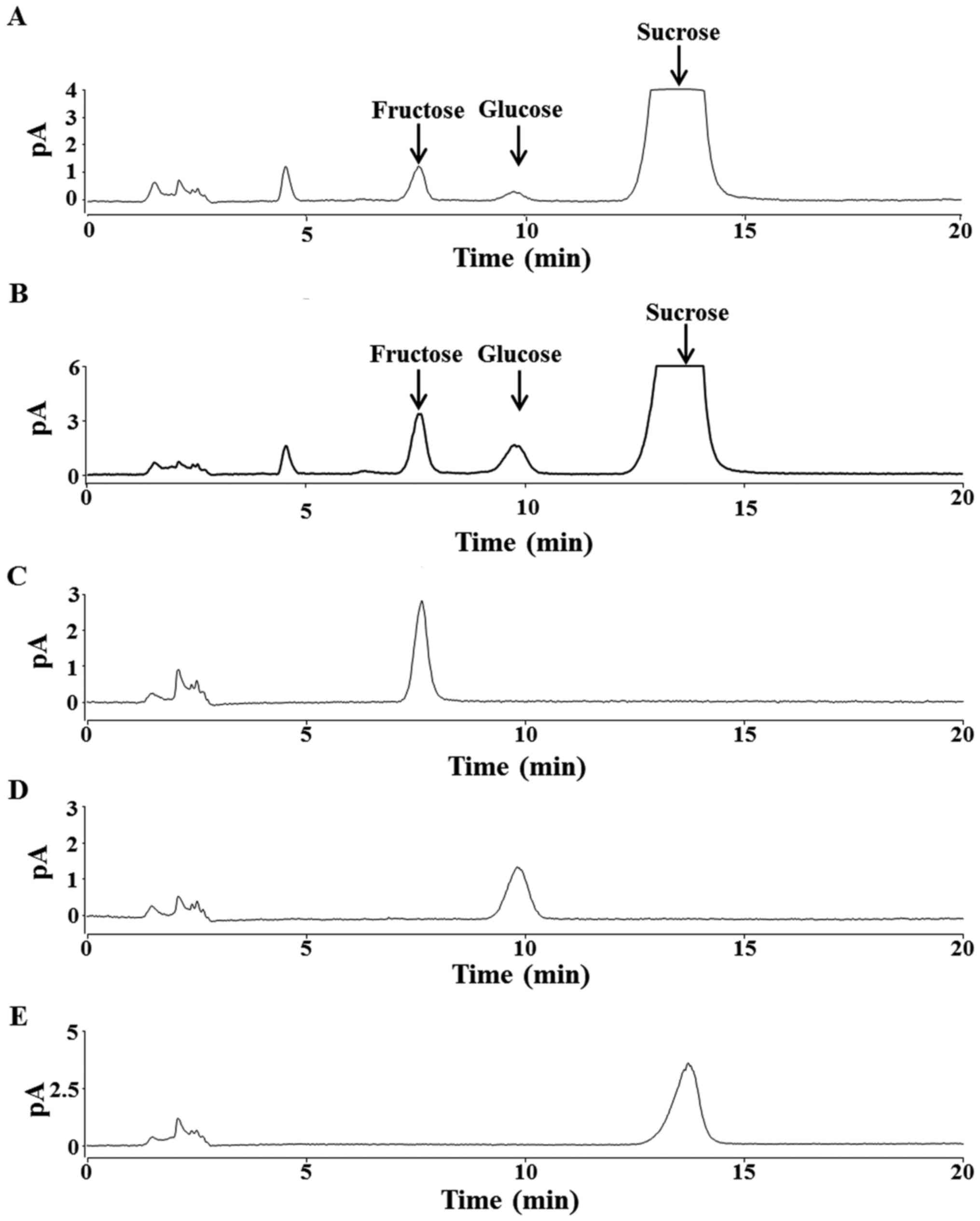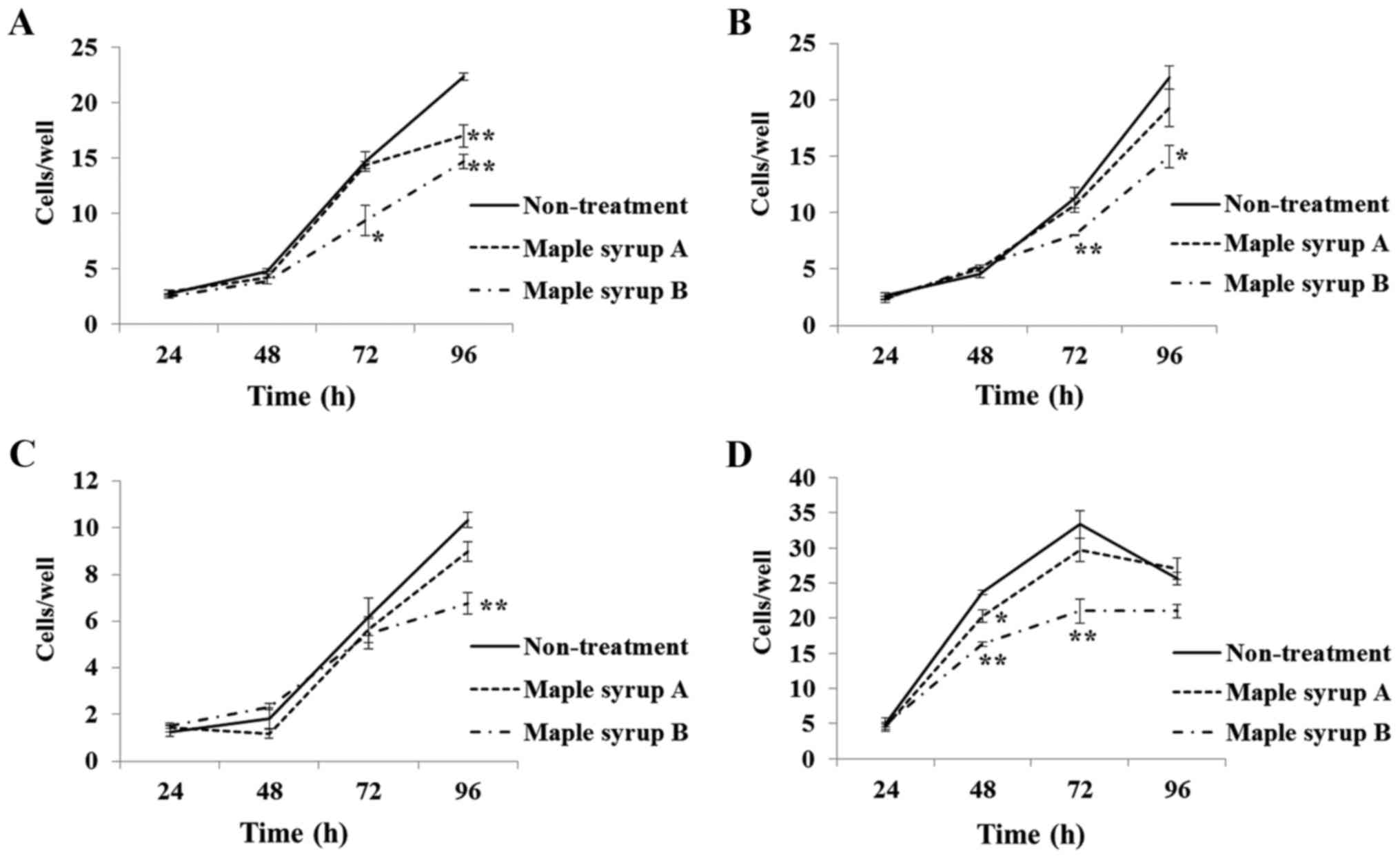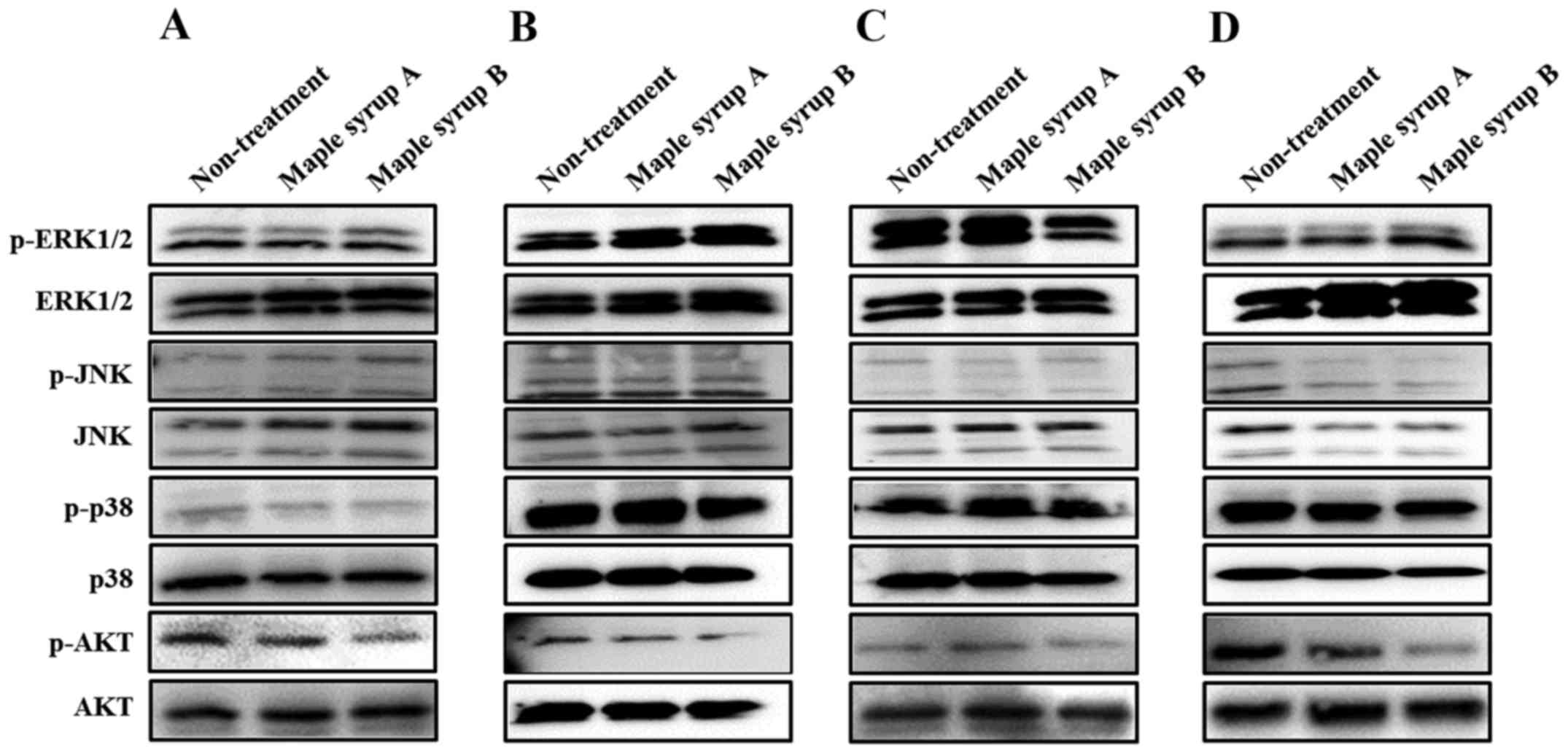|
1
|
Ball DW: The chemical composition of maple
syrup. J Chem Educ. 84:1647–U1646. 2007. View Article : Google Scholar
|
|
2
|
Perkins TD and van den Berg AK: Maple
syrup-production, composition, chemistry, and sensory
characteristics. Adv Food Nutr Res. 56:101–143. 2009. View Article : Google Scholar : PubMed/NCBI
|
|
3
|
Arnason T, Hebda RJ and Johns T: Use of
plants for food and medicine by Native Peoples of eastern Canada.
Can J Bot. 59:2189–2325. 1981. View
Article : Google Scholar
|
|
4
|
Davison RM and Young H: Abscisic-acid
content of xylem sap. Planta. 109:95–98. 1973. View Article : Google Scholar : PubMed/NCBI
|
|
5
|
Taga A, Sato A, Suzuki K, Takeda M and
Kodama S: Simple determination of a strongly aromatic compound,
sotolon, by capillary electrophoresis. J Oleo Sci. 61:45–48. 2012.
View Article : Google Scholar : PubMed/NCBI
|
|
6
|
Taga A and Kodama S: Analysis of reducing
carbohydrates and fructosyl saccharides in maple syrup and maple
sugar by CE. Chromatographia. 75:1009–1016. 2012. View Article : Google Scholar
|
|
7
|
Storz G, Darvill AG and Albersheim P:
Characterization of polysaccharides isolated from maple syrup.
Phytochemistry. 25:437–441. 1986. View Article : Google Scholar
|
|
8
|
Sun J, Ma H, Seeram NP and Rowley DC:
Detection of Inulin, a Prebiotic Polysaccharide, in Maple Syrup. J
Agric Food Chem. 64:7142–7147. 2016. View Article : Google Scholar : PubMed/NCBI
|
|
9
|
Apostolidis E, Li LY, Lee C and Seeram NP:
In vitro evaluation of phenolic-enriched maple syrup extracts for
inhibition of carbohydrate hydrolyzing enzymes relevant to type 2
diabetes management. J Funct Foods. 3:100–106. 2011. View Article : Google Scholar
|
|
10
|
Legault J, Girard-Lalancette K, Grenon C,
Dussault C and Pichette A: Antioxidant activity, inhibition of
nitric oxide overproduction, and in vitro antiproliferative effect
of maple sap and syrup from Acer saccharum. J Med Food. 13:460–468.
2010. View Article : Google Scholar : PubMed/NCBI
|
|
11
|
González-Sarrías A, Li L and Seeram NP:
Effects of maple (Acer) plant part extracts on proliferation,
apoptosis and cell cycle arrest of human tumorigenic and
non-tumorigenic colon cells. Phytother Res. 26:995–1002. 2012.
View Article : Google Scholar : PubMed/NCBI
|
|
12
|
Li L and Seeram NP: Maple syrup
phytochemicals include lignans, coumarins, a stilbene, and other
previously unreported antioxidant phenolic compounds. J Agric Food
Chem. 58:11673–11679. 2010. View Article : Google Scholar : PubMed/NCBI
|
|
13
|
Theriault M, Caillet S, Kermasha S and
Lacroix M: Antioxidant, antiradical and antimutagenic activities of
phenolic compounds present in maple products. Food Chem.
98:490–501. 2006. View Article : Google Scholar
|
|
14
|
Hawco CLA, Wang Y, Taylor M and Weaver DF:
A maple syrup extract prevents β-amyloid aggregation. Can J Neurol
Sci. 43:198–201. 2016. View Article : Google Scholar : PubMed/NCBI
|
|
15
|
Aaron C, Beaudry G, Parker JA and Therrien
M: Maple Syrup Decreases TDP-43 Proteotoxicity in a Caenorhabditis
elegans Model of Amyotrophic Lateral Sclerosis (ALS). J Agric Food
Chem. 64:3338–3344. 2016. View Article : Google Scholar : PubMed/NCBI
|
|
16
|
Maisuria VB, Hosseinidoust Z and Tufenkji
N: Polyphenolic extract from maple syrup potentiates antibiotic
susceptibility and reduces biofilm formation of pathogenic
bacteria. Appl Environ Microbiol. 81:3782–3792. 2015. View Article : Google Scholar : PubMed/NCBI
|
|
17
|
Ma H, DaSilva NA, Liu W, Nahar PP, Wei Z,
Liu Y, Pham PT, Crews R, Vattem DA, Slitt AL, et al: Effects of a
Standardized Phenolic-Enriched Maple Syrup Extract on β-Amyloid
Aggregation, Neuroinflammation in Microglial and Neuronal Cells,
and β-Amyloid Induced Neurotoxicity in Caenorhabditis elegans.
Neurochem Res. 41:2836–2847. 2016. View Article : Google Scholar : PubMed/NCBI
|
|
18
|
Nagai N, Ito Y and Taga A: Comparison of
the enhancement of plasma glucose levels in type 2 diabetes Otsuka
Long-Evans Tokushima Fatty rats by oral administration of sucrose
or maple syrup. J Oleo Sci. 62:737–743. 2013. View Article : Google Scholar : PubMed/NCBI
|
|
19
|
Yamamoto T, Uemura K, Moriyama K, Mitamura
K and Taga A: Inhibitory effect of maple syrup on the cell growth
and invasion of human colorectal cancer cells. Oncol Rep.
33:1579–1584. 2015.PubMed/NCBI
|
|
20
|
Kim YT and Leech RH: Effects of climatic
conditions on sap flow in sugar maple. For Chron. 61:303–307. 1985.
View Article : Google Scholar
|
|
21
|
Marvin JW and Erickson RO: A statistical
evaluation of some of the factors responsible for the flow of sap
from the sugar maple. Plant Physiol. 31:57–61. 1956. View Article : Google Scholar : PubMed/NCBI
|
|
22
|
Plamondon AP and Bernier PY: Modélisation
de la coulée de l'érable à sucre (Acersaccharum Marsh.) à partir
d'éléments météorologiques. Can J Res. 10:152–157. 1980. View Article : Google Scholar
|
|
23
|
Houle D, Paquette A, Côté B, Logan T,
Power H, Charron I and Duchesne L: Impacts of Climate Change on the
Timing of the Production Season of Maple Syrup in Eastern Canada.
PLoS One. 10:e01448442015. View Article : Google Scholar : PubMed/NCBI
|
|
24
|
Stuckel JG and Low NH: The chemical
composition of 80 pure maple syrup samples produced in North
America. Food Res Int. 29:373–379. 1996. View Article : Google Scholar
|
|
25
|
Huang JS, Yao CJ, Chuang SE, Yeh CT, Lee
LM, Chen RM, Chao WJ, Whang-Peng J and Lai GM: Honokiol inhibits
sphere formation and xenograft growth of oral cancer side
population cells accompanied with JAK/STAT signaling pathway
suppression and apoptosis induction. BMC Cancer. 16:2452016.
View Article : Google Scholar : PubMed/NCBI
|
|
26
|
Jiang Y, Zhang Q, Bao J, Du CH, Wang J,
Tong Q and Liu C: Schisandrin B suppresses glioma cell metastasis
mediated by inhibition of mTOR/MMP-9 signal pathway. Biomed
Pharmacother. 74:77–82. 2015. View Article : Google Scholar : PubMed/NCBI
|
|
27
|
Hyun S, Kim MS, Song YS, Bak Y, Ham SY,
Lee DH, Hong J and Yoon DY: Peroxisome proliferator-activated
receptor-gamma agonist 4-O-methylhonokiol induces apoptosis by
triggering the intrinsic apoptosis pathway and inhibiting the
PI3K/Akt survival pathway in SiHa human cervical cancer cells. J
Microbiol Biotechnol. 25:334–342. 2015. View Article : Google Scholar : PubMed/NCBI
|
|
28
|
Zilla MK, Nayak D, Amin H, Nalli Y, Rah B,
Chakraborty S, Kitchlu S, Goswami A and Ali A:
4′-Demethyl-deoxypodophyllotoxin glucoside isolated from
Podophyllum hexandrum exhibits potential anticancer activities by
altering Chk-2 signaling pathway in MCF-7 breast cancer cells. Chem
Biol Interact. 224:100–107. 2014. View Article : Google Scholar : PubMed/NCBI
|
|
29
|
Jeon YJ, Cho JH, Lee SY, Choi YH, Park H,
Jung S, Shim JH and Chae JI: Esculetin Induces Apoptosis Through
EGFR/PI3K/Akt Signaling Pathway and Nucleophosmin Relocalization. J
Cell Biochem. 117:1210–1221. 2016. View Article : Google Scholar : PubMed/NCBI
|
|
30
|
Hsieh CJ, Kuo PL, Hou MF, Hung JY, Chang
FR, Hsu YC, Huang YF, Tsai EM and Hsu YL: Wedelolactone inhibits
breast cancer-induced osteoclastogenesis by decreasing Akt/mTOR
signaling. Int J Oncol. 46:555–562. 2015.PubMed/NCBI
|
|
31
|
Kim WJ, Lee MY, Kim JH, Suk K and Lee WH:
Decursinol angelate blocks transmigration and inflammatory
activation of cancer cells through inhibition of PI3K, ERK and
NF-kappaB activation. Cancer Lett. 296:35–42. 2010. View Article : Google Scholar : PubMed/NCBI
|













